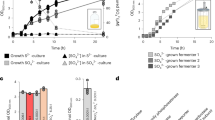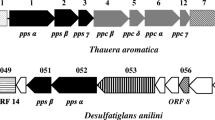Abstract
The ability to use adenosine 5′-phosphosulfate (APS) or 3′-phosphoadenosine 5′-phosphosulfate (PAPS) as the substrate for the initial reductive step in sulfate assimilation has been tested in most of the known Rhodospirillaceae species and in some chemotrophic bacteria. Improved and optimized methods for the synthesis and purification of the sulfonucleotides APS and PAPS are described. The production of acid volatile radioactivity from 35S-APS and 35S-PAPS was measured under various conditions in the presence and absence of non-labeled sulfate. Specific differences in the ability to reduce APS or PAPS were observed among the Rhodospirillaceae species and also the chemotrophic bacteria. APS was found to be the substrate of the thiolsulfotransferase in Rps. acidophila, Rps. globiformis, Rm. vannielii, Rc. purpureus, R. tenue, Rps. gelatinosa, in Alcaligenes eutrophus and Pseudomonas aeruginosa. PAPS was the substrate in Rps. capsulata, Rps. sphaeroides, Rps. sulfidophila, Rps. palustris, Rps. viridis, R. rubrum, R. fulvum, in Paracoccus denitrificans and in several Enterobacteriaceae. The presence of different enzymatic systems for sulfate reduction in the Rhodospirillaceae family is compared with their taxonomical grouping and their possible phylogenetic relatedness.
Similar content being viewed by others
Abbreviations
- APS:
-
adenosine 5′-phosphosulfate
- PAPS:
-
3′-phosphate adenosine 5′-phosphosulfate
- DTE:
-
dithioerythrol
- Rc.:
-
Rhodocyclus
- R.:
-
Rhodospirillum
- Rm.:
-
Rhodomicrobium
- Rps.:
-
Rhodopseudomonas
References
Adams CA, Warnes GM, Nicholas DJD (1971) Preparation of labeled adenosine-5′-phosphosulfate using APS-reductase from Thiobacillus denitrificans. Analyt Biochem 42:207–213
Almassy RJ, Dickerson RE (1978) Pseudomonas cytochrome c551 at 2.0 Å resolution: Enlargement of the cytochrome c family. Proc Natl Acad Sci USA 75:2674–2678
Ambler RP, Daniel M, Hermoso J, Meyer TE, Bartsch RG, Kamen MD (1979) Cytochrome c2 sequence variation among the recognized species of purple non-sulfur photosynthetic bacteria. Nature 278:659–660
Baddiley J, Buchanan JG, Letters R (1957) Synthesis of adenosine-5′-sulfatophosphate. A degradation product of an intermediate in the enzymatic synthesis of sulfuric esters. J Chem Soc 1067–1071
Beisenherz G, Boltze HJ, Bücher T, Czok R, Garbade KH, Meyer-Arendt E, Pfleiderer G (1953) Diphosphofructose-Aldolase, Phosphoglycerinaldehyd-Dehydrogenase, Milchsäure-Dehydrogenase, Glycerophosphat-Dehydrogenase und Pyruvat-Kinase aus Kaninchenmuskel in einem Arbeitsgang. Z Naturforsch 8b:555–557
Buchanan BB, Schürmann P, Kalberer PP (1971) Ferredoxin-activated fructose diphosphatase of spinach chloroplasts. Resolution of the system, properties of the alkaline fructose diphosphatase component, and physiological significance of the ferredoxin-linked activation. J Biol Chem 246:5952–5959
Burnell JN, Whatley FR (1980) Regulation of sulfur metabolism in Paracoccus denitrificans. J Gen Microbiol 118:73–78
Burnell JN, John P, Whatley FR (1975) The reversibility of active transport in membrane vesicles of Paracoccus denitrificans. Biochem J 150:527–536
Cherniak R, Davidson EA (1964) Synthesis of adenylyl sulfate and adenylyl sulfate 3′-phosphate. J Biol Chem 239:2986–2990
Cooper BP, Trüper HG (1979) Improved synthesis and rapid isolation of millimole quantities of adenylyl-sulfate. Z Naturforsch 34c:346–349
De Bont JAM, Scholten A, Hansen TA (1981) DNA-DNA hybridization of Rhodopseudomonas capsulata, Rhodopseudomonas sphaeroides and Rhodopseudomonas sulfidophila strains. Arch Microbiol 128:271–274
De Ley J, Segers P, Gillis M (1978) Intra-and intergeneric similarities of Chromobacterium and Janthinobacterium ribosomal ribonucleic acid cistrons. Int J Syst Bacteriol 28:154–168
Dreyfuss J, Monty KJ (1963) The biochemical characterization of cysteine-requiring mutants of Salmonella typhimurium. J Biol Chem 238:1019–1024
Gibson J, Stackebrandt E, Zablen LB, Gupta R, Woese CR (1979) A phylogenetic analysis of the purple photosynthetic bacteria. Current Microbiol 3:59–64
Gottschalk G (1964) Die Biosynthese der Poly-β-hydroxybuttersäure durch Knallgasbakterien. II. Verwertung organischer Säuren. Arch Mikrobiol 47:230–235
Hodson RC, Schiff JA (1969) Preparation of adenosine-3′-phosphate-5′-phosphosulfate (PAPS): an improved enzymatic method using Chlorella pyrenoidosa. Arch Biochem Biophys 132:151–156
Imhoff JF, Trüper HG (1977) Ectothiorhodospira halochloris sp. nov., a new extremely halophilic phototrophic bacterium containing bacteriochlorophyll b. Arch Microbiol 114:115–121
Kredich NM (1971) Regulation of l-cysteine biosynthesis in Salmonella typhimurium. I. Effects of growth on varying sulfur sources and O-acetyl-l-serine on gene expression. J Biol Chem 246:3474–3484
MacKay RM, Zablen LB, Woese CR, Doolittle WF (1979) Homologies in processing and sequence between the 23 S ribosomal ribonucleic acids of Paracoccus denitrificans and Rhodopseudomonas sphaeroides. Arch Microbiol 123:165–172
Pasternak CA, Ellis RJ, Jones-Mortimer MC, Crichton CE (1965) The control of sulphate reduction in bacteria. Biochem J 96:270–275
Peck HD (1961) Enzymatic basis for assimilatory and dissimilatory sulfate reduction. J Bacteriol 82:933–939
Pfennig N (1974) Rhodopseudomonas globiformis, sp. nov., a new species of the Rhodospirillaceae. Arch Microbiol 100:197–206
Robbins PW (1963) Preparation and properties of sulfur adenylates. In: Colowick SP, Kaplan NO (eds) Methods in enzymology. Academic Press, New York, vol VI, pp 766–775
Schedel M (1978) Untersuchungen zur anaeroben Oxidation reduzierter Schwefelverbindungen durch Thiobacillus denitrificans, Chromatium vinosum und Chlorobium limicola. PhD Thesis, University of Bonn
Schmidt A (1972) On the mechanism of photosynthetic sulfate reduction. An APS-sulfotransferase from Chlorella. Arch Mikrobiol 84:77–86
Schmidt A (1975) Distribution of the APS-sulfotransferase activity among higher plants. Plant Sci Lett 5:407–415
Schmidt A (1977a) Assimilatory sulfate reduction via 3′-phospho-adenosine-5′-phosphosulfate (PAPS) and adenosine-5′-phosphosulfate (APS) in blue-green algae. FEMS Lett 1:137–140
Schmidt A (1977b) Adenosine-5′-phosphosulfate (APS) as sulfate donor for assimilatory sulfate reduction in Rhodospirillum rubrum. Arch Microbiol 112:263–270
Schmidt A, Abrams WR, Schiff JA (1974) Reduction of adenosine-5′-phosphosulfate to cysteine in extracts from Chlorella and mutants blocked for sulfate reduction. Eur J Biochem 47:423–434
Schmidt A, Trüper HG (1977) Reduction of adenylsulfate and 3′-phosphoadenylsulfate in phototrophic bacteria. Experientia 33:1008–1009
Seewaldt E, Schleifer KH, Bock E, Stackebrandt E (1982) The close phylogenetic relationship of Nitrobacter and Rhodospeudomonas palustris. Arch Microbiol 131:287–290
Tsang MLS, Lenieux J, Schiff JA, Bojarski TB (1976) Preparation of adenosine-5′-phosphosulfate (APS) from adenosine-3′-phosphate-5′-phosphosulfate (PAPS) prepared by an improved procedure. Analyt Biochem 74:623–626
Tsang MLS, Schiff JA (1975) Studies of sulfate utilization by algae. 14. Distribution of adenosine-3′-phosphate-5′-phosphosulfate (PAPS) and adenosine-5′-phosphosulfate (APS) sulfotransferases in assimilatory sulfate reducers Plant Sci Lett 4:301–307
Tsang MLS, Schiff JA (1976) Sulfate-reducing pathway in Escherichia coli involving bound intermediates. J Bacteriol 125:923–933
Tuovinen OH, Kelley BC, Nicholas DJD (1975) The uptake and assimilation of sulphate by Thiobacillus ferrooxidans. Arch Microbiol 105:123–127
varma AK, Nicholas DJD (1971) Metabolism of 35S-sulfate and properties of APS-kinase and PAPS-reductase in Nitrobacter agilis. Arch Mikrobiol 78:99–117
Wilson LG, Asahi T, Bandurski RS (1961) Yeast sulfate-reducing system. I. Reduction of sulfate to sulfite. J Biol Chem 236:1822–1829
Wilson LG, Bierer D (1976) The formation of exchangeable sulfite from adenosine-3′-phosphate-5′-sulfatophosphate in yeast. Biochem J 158:255–270
Author information
Authors and Affiliations
Rights and permissions
About this article
Cite this article
Imhoff, J.F. Occurrence and evolutionary significance of two sulfate assimilation pathways in the rhodospirillaceae. Arch. Microbiol. 132, 197–203 (1982). https://doi.org/10.1007/BF00508731
Received:
Accepted:
Issue Date:
DOI: https://doi.org/10.1007/BF00508731




